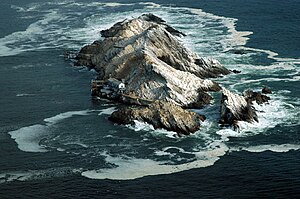
The Namibian Coast Conservation and Management Project (NACOMA) is a conservation and wildlife monitoring project operating in Namibia. NACOMA, as it is known, was officially launched in March 2006 as a five-year project co-funded by the Global Environmental Facility (GEF) and the Namibian government with the support of the World Bank.
NACOMA's objectives are to prevent the loss of biodiversity and coastal degradation in Namibia and to promote sustainable development which comply with global environmental demands on a localised and national level.
NACOMA supports scientific monitoring and research along the coast of Namibia including Mercury Island, Ichaboe Island, Halifax Island and Possession Island, islands which support the entire Namibian breeding population of Cape gannets Morus capensis, 96% of the Namibian population of the endangered African penguin Spheniscus demersus, and nearly 90% of the global breeding population of bank cormorants Phalacrocorax neglectus.
References
- "Walk on our coastline". Namibian Coast Conservation and Management Project. Archived from the original on July 21, 2009. Retrieved October 21, 2008.
External links
This Namibia-related article is a stub. You can help Misplaced Pages by expanding it. |